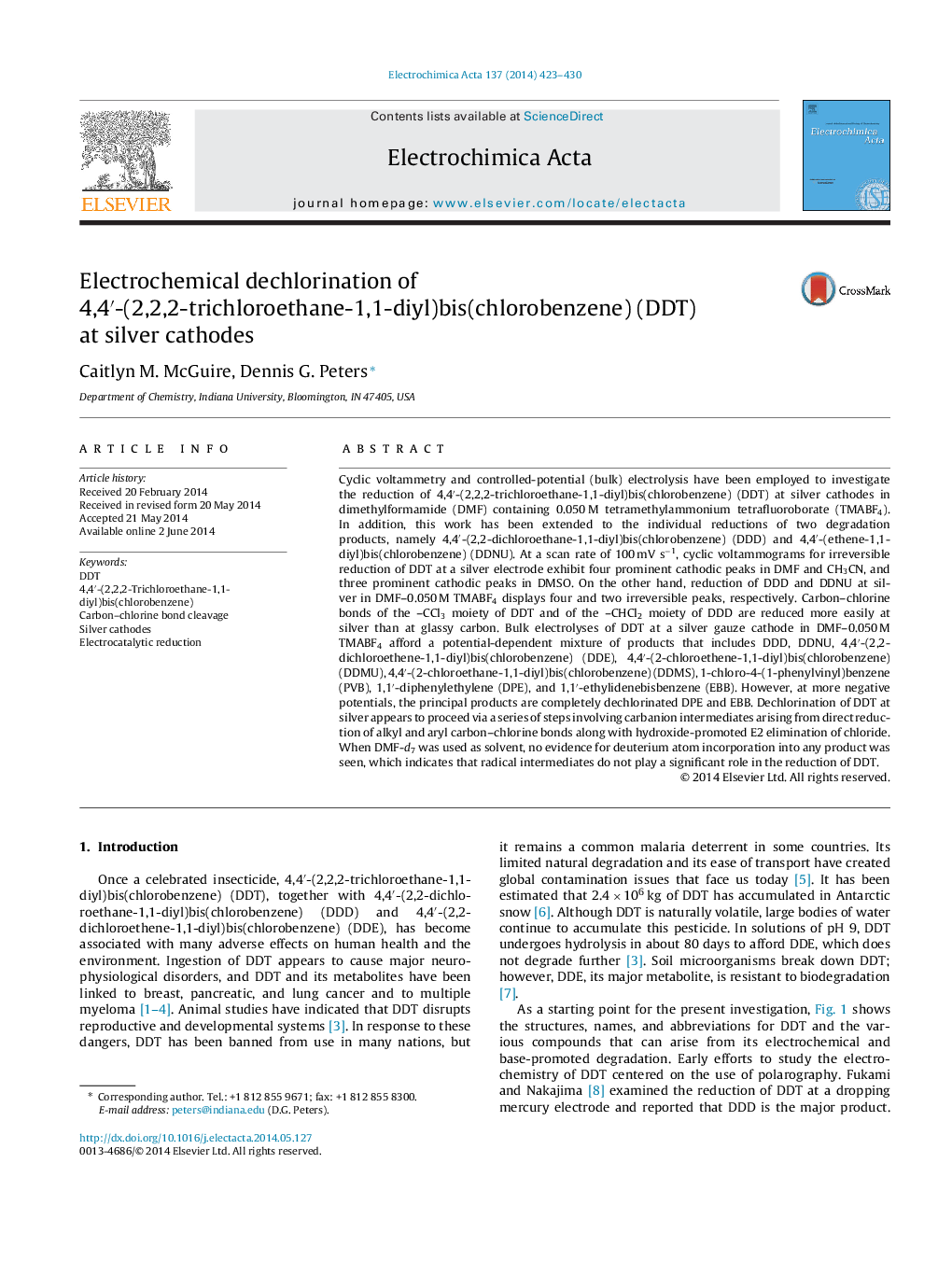| کد مقاله | کد نشریه | سال انتشار | مقاله انگلیسی | نسخه تمام متن |
|---|---|---|---|---|
| 185592 | 459599 | 2014 | 8 صفحه PDF | دانلود رایگان |

• Complete dechlorination of DDT occurs at silver electrodes in DMF and DMF–H2O.
• Aliphatic chlorines of DDT are cleaved more readily at silver than at carbon cathodes.
• Voltammograms at 100 mV s−1 show four prominent cathodic peaks for DDT at Ag in DMF.
• DDT degrades via direct cleavage of C–Cl bonds and base-catalyzed elimination of Cl−.
Cyclic voltammetry and controlled-potential (bulk) electrolysis have been employed to investigate the reduction of 4,4′-(2,2,2-trichloroethane-1,1-diyl)bis(chlorobenzene) (DDT) at silver cathodes in dimethylformamide (DMF) containing 0.050 M tetramethylammonium tetrafluoroborate (TMABF4). In addition, this work has been extended to the individual reductions of two degradation products, namely 4,4′-(2,2-dichloroethane-1,1-diyl)bis(chlorobenzene) (DDD) and 4,4′-(ethene-1,1-diyl)bis(chlorobenzene) (DDNU). At a scan rate of 100 mV s−1, cyclic voltammograms for irreversible reduction of DDT at a silver electrode exhibit four prominent cathodic peaks in DMF and CH3CN, and three prominent cathodic peaks in DMSO. On the other hand, reduction of DDD and DDNU at silver in DMF–0.050 M TMABF4 displays four and two irreversible peaks, respectively. Carbon–chlorine bonds of the –CCl3 moiety of DDT and of the –CHCl2 moiety of DDD are reduced more easily at silver than at glassy carbon. Bulk electrolyses of DDT at a silver gauze cathode in DMF–0.050 M TMABF4 afford a potential-dependent mixture of products that includes DDD, DDNU, 4,4′-(2,2-dichloroethene-1,1-diyl)bis(chlorobenzene) (DDE), 4,4′-(2-chloroethene-1,1-diyl)bis(chlorobenzene) (DDMU), 4,4′-(2-chloroethane-1,1-diyl)bis(chlorobenzene) (DDMS), 1-chloro-4-(1-phenylvinyl)benzene (PVB), 1,1′-diphenylethylene (DPE), and 1,1′-ethylidenebisbenzene (EBB). However, at more negative potentials, the principal products are completely dechlorinated DPE and EBB. Dechlorination of DDT at silver appears to proceed via a series of steps involving carbanion intermediates arising from direct reduction of alkyl and aryl carbon–chlorine bonds along with hydroxide-promoted E2 elimination of chloride. When DMF-d7 was used as solvent, no evidence for deuterium atom incorporation into any product was seen, which indicates that radical intermediates do not play a significant role in the reduction of DDT.
Journal: Electrochimica Acta - Volume 137, 10 August 2014, Pages 423–430